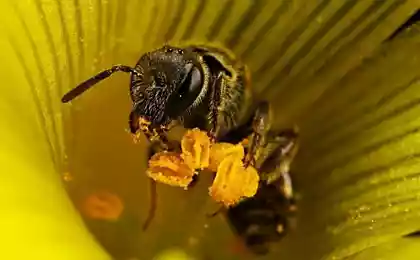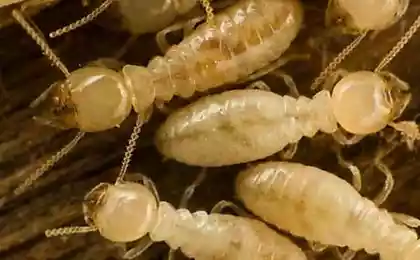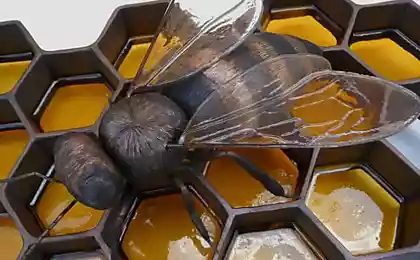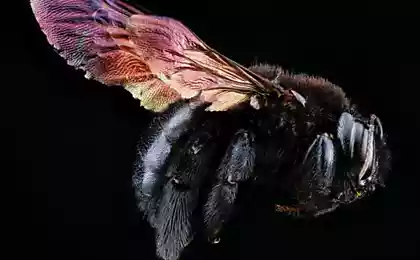414
Bee glue and why are you crying trees
This amazing tree is the birch. Only will roast in the summer sun, both of her spare kidney, hidden in the axils of the leaves, rolled a faint, fragrant resinous amber droplets.
They are sticky, and touching them with your finger, we can pull a pretty long thread. Cracked, it will leave a mark that will long Strait drunk the fragrance of the birch forest.
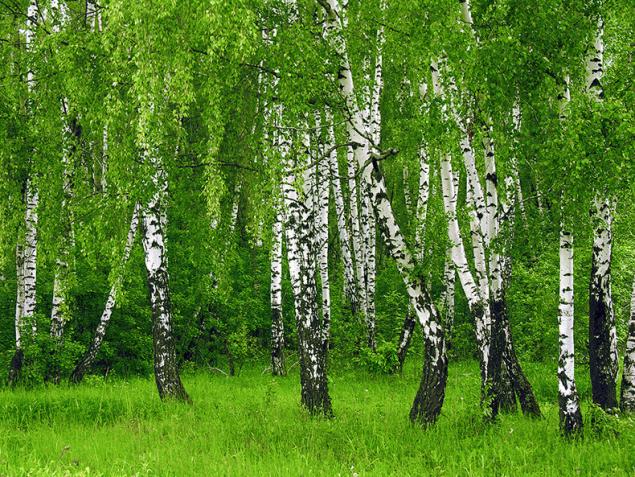
Suddenly you can welcome a bee. Twist and seemed confused pogodi around you, it will disappear, leaving vis to wonder about the purpose of his visit.
These allocations are axillary buds in Ancient Greece was called the "tears" of trees. Observations do show that "cry" not only birch, but also bigger and dark "tears" – handsome poplar and the much rarer and smaller tears his cousin, forever shy trembling aspen. And there are "crybabies" in the woods, alder same, for example, elm, willow, and a resident of the more southern places – a horse chestnut.
What causes this universal summer "weeping" trees and why they are the amber drops which are pleasant to our sense of smell, are of interest in the bees – the famous sorcerers of the vegetable Kingdom? These poeticized creatures really strict rationalists: they contribute to your grad only what benefits the colony.
What ties the bees with "lament" wood beauties? It turns out bees are well aware of the droplets of the tears, roll out in the nice summer days from under the scales of spare buds of trees. They even have a very strict "pecking". Birch "tears" in it, for example, is the most high and honorable place. And not all tears, even the same birch. Chemists found that their composition changed, although the strictly regulated limits. Bees clearly prefer the ones that are particularly rich composition: up to 50 connections! Many of them are already allocated and identified by scientists.
Indeed, the droplet was not easy. Many biologically active compounds. So, some terpenes, aromatic forming part of the discharge, with negligible concentrations inhibit the growth of other plant species.
Polyphenols, of which there are especially a lot, show strong antimicrobial action; there are those that prevent the attack of larvae of harmful insects. What comes out is a deeply layered chemical defense of the vital center of plants – his kidneys?

It seems that way. For the greedy microbes, insects and plant competitors area birch "weeping" is deadly. White-trunked beauty suddenly turns into a kind of ANCHAR for those who are eager to profit at the expense of its tender leaves, juices or capture the feed.
If so, then it becomes clear why "weeping" trees coincides with the warmest days of the year. Populations of dangerous microbes and insects at this time the most numerous, and breeding conditions the most favorable, that is the birch to reflect some of their juices to the creation of the amber droplets that carry resistance to pests.
And what about the bees? We must pay tribute to these insects – bees, apparently, and helped to de-mystify the chemical defence of our forest idols. Millions of years they already collect the precious droplets-tear arising from ordinary-looking buds of birches, aspens, poplars... Bringing to the hive, they add a bit of wax, its other secrets are still not fully known, and get the now famous propolis is a faithful guardian of the health of bee grad and very useful stuff.
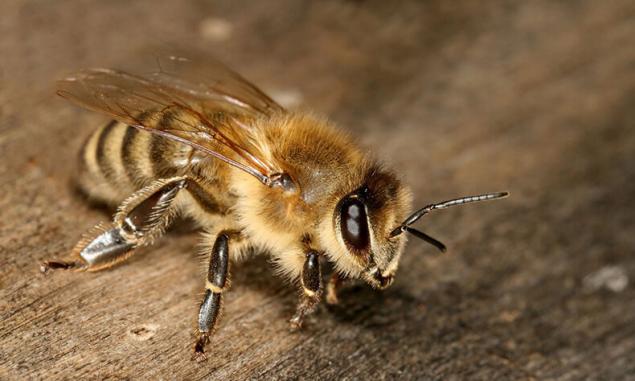
Not like this process, whether you collect nectar and its subsequent transformation into the mysterious honey – a product markedly different in composition and quality from the original nectar? Perhaps touch to this bee mystery here even more exciting: because the bees prepare propolis, essentially, can healing drops seem directly intended by nature for security purpose!
But the bees have something to defend in hives of hundreds of thousands (!) barrels-cells and filled to the brim with honey, in the tens of thousands of others – it is the intense "cooking", and thousands more filled with colorful pollen – protein feed family. But especially responsible role of cells, which are curled pearl rings, larvae of bees.
Such cells also thousands. Germs are especially dangerous: at high humidity the temperature of the nests is strictly kept within 34...35. Invisible aggressors, of course, rush to this Paradise, but... something stops them. No wonder the hive is still synonymous with purity and guaranteed freshness made in it products. Long does not lose its healing power and propolis.
It turns out that droplets-tears of white-trunked birches are another fundamental importance of service, protecting honey hail from decay, fermentation, and all infectious scourge. Bee propolis in the hive cover everything: the cells of a honeycomb, PetroChina, the walls of the hive, immure pests, finally, are folded, as they found, there are many in stock. In small bugorkov-growths we meet him on the framework, halstenbach, walls.
So, people inhale the healing aroma of the forest, chewing a piece of amber comb honey, imposes on the affected area bandage soaked with a solution of bee glue everywhere invisibly present, heal us and strengthen unobtrusive scented "tears" of our eternal green satellites.published
P. S. And remember, only by changing their consumption — together we change the world! ©
Join us in Facebook , Vkontakte, Odnoklassniki
Source: oppps.ru/pchelinyj-klej-i-pochemu-plachut-derevya.html
They are sticky, and touching them with your finger, we can pull a pretty long thread. Cracked, it will leave a mark that will long Strait drunk the fragrance of the birch forest.

Suddenly you can welcome a bee. Twist and seemed confused pogodi around you, it will disappear, leaving vis to wonder about the purpose of his visit.
These allocations are axillary buds in Ancient Greece was called the "tears" of trees. Observations do show that "cry" not only birch, but also bigger and dark "tears" – handsome poplar and the much rarer and smaller tears his cousin, forever shy trembling aspen. And there are "crybabies" in the woods, alder same, for example, elm, willow, and a resident of the more southern places – a horse chestnut.
What causes this universal summer "weeping" trees and why they are the amber drops which are pleasant to our sense of smell, are of interest in the bees – the famous sorcerers of the vegetable Kingdom? These poeticized creatures really strict rationalists: they contribute to your grad only what benefits the colony.
What ties the bees with "lament" wood beauties? It turns out bees are well aware of the droplets of the tears, roll out in the nice summer days from under the scales of spare buds of trees. They even have a very strict "pecking". Birch "tears" in it, for example, is the most high and honorable place. And not all tears, even the same birch. Chemists found that their composition changed, although the strictly regulated limits. Bees clearly prefer the ones that are particularly rich composition: up to 50 connections! Many of them are already allocated and identified by scientists.
Indeed, the droplet was not easy. Many biologically active compounds. So, some terpenes, aromatic forming part of the discharge, with negligible concentrations inhibit the growth of other plant species.
Polyphenols, of which there are especially a lot, show strong antimicrobial action; there are those that prevent the attack of larvae of harmful insects. What comes out is a deeply layered chemical defense of the vital center of plants – his kidneys?

It seems that way. For the greedy microbes, insects and plant competitors area birch "weeping" is deadly. White-trunked beauty suddenly turns into a kind of ANCHAR for those who are eager to profit at the expense of its tender leaves, juices or capture the feed.
If so, then it becomes clear why "weeping" trees coincides with the warmest days of the year. Populations of dangerous microbes and insects at this time the most numerous, and breeding conditions the most favorable, that is the birch to reflect some of their juices to the creation of the amber droplets that carry resistance to pests.
And what about the bees? We must pay tribute to these insects – bees, apparently, and helped to de-mystify the chemical defence of our forest idols. Millions of years they already collect the precious droplets-tear arising from ordinary-looking buds of birches, aspens, poplars... Bringing to the hive, they add a bit of wax, its other secrets are still not fully known, and get the now famous propolis is a faithful guardian of the health of bee grad and very useful stuff.

Not like this process, whether you collect nectar and its subsequent transformation into the mysterious honey – a product markedly different in composition and quality from the original nectar? Perhaps touch to this bee mystery here even more exciting: because the bees prepare propolis, essentially, can healing drops seem directly intended by nature for security purpose!
But the bees have something to defend in hives of hundreds of thousands (!) barrels-cells and filled to the brim with honey, in the tens of thousands of others – it is the intense "cooking", and thousands more filled with colorful pollen – protein feed family. But especially responsible role of cells, which are curled pearl rings, larvae of bees.
Such cells also thousands. Germs are especially dangerous: at high humidity the temperature of the nests is strictly kept within 34...35. Invisible aggressors, of course, rush to this Paradise, but... something stops them. No wonder the hive is still synonymous with purity and guaranteed freshness made in it products. Long does not lose its healing power and propolis.
It turns out that droplets-tears of white-trunked birches are another fundamental importance of service, protecting honey hail from decay, fermentation, and all infectious scourge. Bee propolis in the hive cover everything: the cells of a honeycomb, PetroChina, the walls of the hive, immure pests, finally, are folded, as they found, there are many in stock. In small bugorkov-growths we meet him on the framework, halstenbach, walls.
So, people inhale the healing aroma of the forest, chewing a piece of amber comb honey, imposes on the affected area bandage soaked with a solution of bee glue everywhere invisibly present, heal us and strengthen unobtrusive scented "tears" of our eternal green satellites.published
P. S. And remember, only by changing their consumption — together we change the world! ©
Join us in Facebook , Vkontakte, Odnoklassniki
Source: oppps.ru/pchelinyj-klej-i-pochemu-plachut-derevya.html



